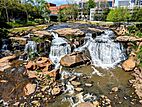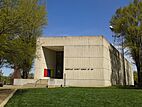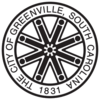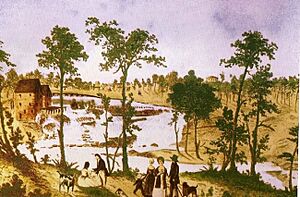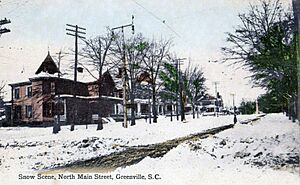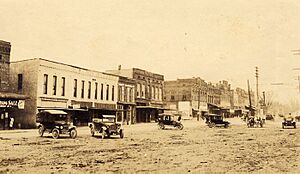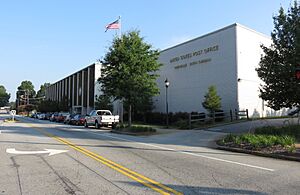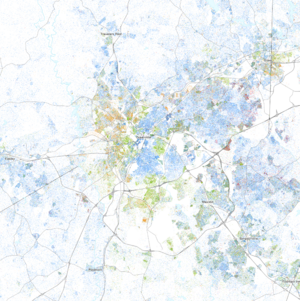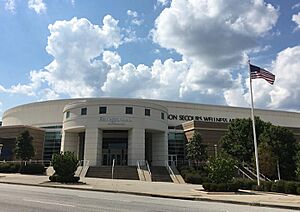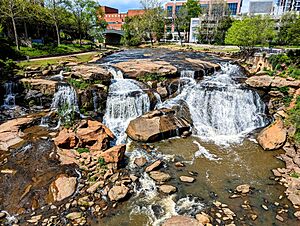Greenville, South Carolina facts for kids
Quick facts for kids
Greenville
|
|||
|---|---|---|---|
|
Downtown Greenville
Greenville County Museum of Art
Peace Center
Furman University
|
|||
|
|||
| Nickname(s):
G-Vegas/Green Vegas, GVL
|
|||
| Country | United States | ||
| State | South Carolina | ||
| County | Greenville | ||
| Incorporated (as a village) | December 17, 1831 | ||
| Named for | Nathanael Greene | ||
| Area | |||
| • Total | 30.02 sq mi (77.76 km2) | ||
| • Land | 29.80 sq mi (77.17 km2) | ||
| • Water | 0.23 sq mi (0.58 km2) 0.77% | ||
| • Urban | 320 sq mi (830 km2) | ||
| • Metro | 2,790 sq mi (7,220 km2) | ||
| Elevation | 984 ft (300 m) | ||
| Population
(2020)
|
|||
| • Total | 70,720 | ||
| • Estimate
(2023)
|
72,824 | ||
| • Rank | SC: 6th | ||
| • Density | 2,373.39/sq mi (916.37/km2) | ||
| • Urban | 387,271 (US: 109th) | ||
| • Urban density | 1,477.2/sq mi (570.3/km2) | ||
| • Metro | 975,480 (US: 57th) | ||
| Demonym(s) | Greenvillian | ||
| Time zone | UTC−5 (EST) | ||
| • Summer (DST) | UTC−4 (EDT) | ||
| ZIP Codes |
29601–29617
|
||
| Area codes | 864, 821 | ||
| FIPS code | 45-30850 | ||
| GNIS feature ID | 1245842 | ||
Greenville is a city in South Carolina, United States. It is the main city of Greenville County. In 2020, about 70,720 people lived there. This makes it the sixth-largest city in South Carolina. The larger Greenville area, which includes nearby towns, has almost a million people. It is the biggest metro area in South Carolina. Greenville is also the main city of the Upstate region, which has about 1.59 million people.
Greenville was started in 1797 and became a village in 1831. It is located about halfway between Atlanta, Georgia and Charlotte, North Carolina. Many big companies have offices in Greenville. These include Michelin, Prisma Health, and Duke Energy.
Contents
History of Greenville
From Cherokee Land to a New County
The land where Greenville is today was once used for hunting by the Cherokee people. Colonists were not allowed to hunt there. A rich settler named Richard Pearis came to South Carolina around 1754. He became friends with the Cherokee. Pearis had a child with a Cherokee woman. He received about 100,000 acres of land from the Cherokee around 1770.
Pearis built a large farm called the Great Plains. It was located on the Reedy River in what is now downtown Greenville. During the American Revolution, people in South Carolina chose sides. Some were Loyalists who supported the British. Others were Patriots who wanted to be free. Pearis supported the Loyalists. He and his Cherokee friends attacked the Patriots. The Patriots fought back. They burned Pearis' farm and put him in jail. Pearis never came back to his farm. However, Paris Mountain is named after him.
In 1777, the Treaty of Dewitt's Corner was signed. This treaty gave almost all Cherokee land to South Carolina. This included the land where Greenville is now.
Greenville's Early Years
Greenville County was created in 1786. Some say it was named for its green landscape. Others believe it was named after General Nathanael Greene. He was a hero in the American Revolutionary War. It might also be named after an early settler, Isaac Green.
In 1788, Lemuel J. Alston came to Greenville County. He bought 400 acres of land. This included part of Pearis' old farm. In 1797, Alston started a village called Pleasantburg on his land. He also built a grand house.
In 1816, Vardry McBee bought Alston's land. McBee first rented the Alston house as a summer resort. Then, from 1835 until he died in 1864, it was his home. Pleasantburg was renamed Greenville in 1821. It became a village in 1831. McBee is known as the "father of Greenville." He gave land for many buildings. These included churches, schools, and a cotton mill.
McBee also helped bring Furman University to Greenville in 1851. In 1853, McBee and other leaders helped fund a new railroad. It was called the Greenville and Columbia Railroad. Greenville grew quickly in the 1850s. Its population reached about 1,000 people. This was due to McBee's gifts and the town's popularity as a summer resort.
Greenville in the Late 1800s
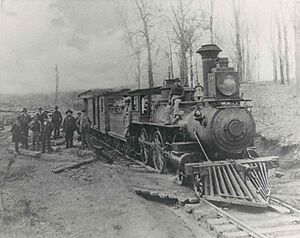
In December 1860, Greenville supported a meeting. The meeting was to discuss if South Carolina should leave the Union. Greenville sent five delegates to this meeting. On December 20, 1860, South Carolina voted to leave the Union. Greenville's delegates voted for this too.
Greenville County sent over 2,000 soldiers to the Confederate States Army. The town provided food, clothes, and weapons to the Confederacy. Greenville did not see fighting until 1865. Then, Union troops came through. They were looking for Jefferson Davis, the Confederate President. He had fled south from Richmond, Virginia. In June 1865, President Andrew Johnson chose Benjamin Franklin Perry to be the Governor of South Carolina. Perry was from Greenville County.
In February 1869, Greenville became a city. This was decided by the South Carolina General Assembly. Building grew fast in the 1870s. A new bridge was built over the Reedy River. New mills and railroads also appeared. The Greenville News started in 1874. It was Greenville's first daily newspaper. Southern Bell installed the city's first telephone lines.
Cotton mills were very important to the city. Many large cotton mill businesses operated near Greenville. This made it a "cotton mill town." By 1915, Greenville was known as the "Textile Center of the South." From 1915 to 2004, the city hosted a big textile trade fair. It was called the Southern Textile Exposition.
Greenville in the 1900s
During World War I, Greenville was a training camp for US Army soldiers. After the war, businesses grew. New movie theaters and department stores opened. The old Mansion House was torn down. The Poinsett Hotel was built in its place in 1925.
The Great Depression hurt Greenville's economy. Mills had to lay off workers. Furman University and the Greenville Women's College struggled. They had to combine in 1933. The Textile Workers Strike of 1934 greatly affected the city. The National Guard was called in to stop the strike. The New Deal helped build Sirrine Stadium and a new Greenville High School. The Greenville Army Air Base was built in 1942 during World War II. This helped Greenville grow even more.
After the war, a propane explosion happened on November 19, 1946. Six people died and over 150 were hurt. The explosion was heard 50 miles away.
After World War II, Greenville's economy boomed. New stores opened and the city grew in size. Furman University's student numbers doubled. It moved to a new location. More colleges were built. These included Bob Jones University in 1947 and Greenville Technical College in 1962. The Greenville–Spartanburg International Airport opened in 1962. It was built in nearby Greer. In 1966, the Landmark Building was built. It is still the city's tallest building.
Greenville's economy slowed down in the 1970s. Many stores left the city. Mayor Max Heller started a plan to make the city better. He helped create the Greenville County Museum of Art and the Hughes Main Library. Main Street was changed to a two-lane road. It was lined with trees and sidewalks. In 1978, a federal grant helped build a convention center and hotel. This brought businesses back to the area.
In the early 1980s, Bill Workman became mayor in 1983. He focused on growing the economy. He and the chamber of commerce convinced Michelin to move its North American headquarters to Greenville in 1984. Many other companies also moved to Greenville. These included Bowater in 1992. The Greenville Municipal Stadium was built in 1984. The city also helped develop the West End Market project. This created an arts and entertainment area.
In 1990, the Peace Center arts venue opened downtown. In 1994, BMW opened its first factory outside Germany. It was built between Greenville and Spartanburg. Knox White became mayor in 1995. In 1998, the Bon Secours Wellness Arena opened. It replaced the old Greenville Memorial Auditorium. The Poinsett Hotel was updated in the late 1990s. The Camperdown Bridge was removed. It had blocked the view of the falls for decades. A new Falls Park was built instead.
Greenville in the 2000s
In the 2000s, many people moved to Greenville. The Liberty Bridge at Falls Park was finished in 2004. It became a famous landmark. Greenville has kept growing. In 2020, over 70,000 people lived in the city. Its growth has also helped nearby cities like Simpsonville and Mauldin. Under Mayor Knox White, the Swamp Rabbit Trail opened in 2010. This old railroad line was turned into a path. Hundreds of thousands of tourists visit it every year.
Greenville's Location and Climate
Geography of Greenville
Greenville is about halfway between Atlanta (145 miles southwest) and Charlotte, North Carolina (100 miles northeast). Columbia, the state capital, is 100 miles to the southeast.
Greenville is in the foothills of the Blue Ridge Mountains. These are part of the larger Appalachian Mountains. The city has many small hills. Sassafras Mountain, the highest point in South Carolina, is less than 40 miles northwest of Greenville. Many TV and radio towers are on Paris Mountain. This is the second-highest peak nearby. It is 8 miles north of downtown Greenville.
The city covers about 30 square miles. Most of this is land, with a small amount of water. The Reedy River flows through the middle of the city. It is a branch of the Saluda River. Greenville is in the Brevard Fault Zone. This means it sometimes has small earthquakes.
Greenville's Climate
Greenville has a mild humid subtropical climate. It has four clear seasons. Winters are short and cool. The average temperature in January is about 42.2°F. It freezes about 59 nights a year. Only about one day a year stays below freezing. April is the driest month.
Summers are hot and humid. The average temperature in July is about 79.9°F. It reaches 90°F or higher about 43 days a year. The hottest temperature ever recorded was 107°F in 2012. The coldest was -6°F in 1966. Freezing temperatures usually happen from November 4 to April 1. This gives a long growing season of 217 days.
Greenville gets about 47.2 inches of rain each year. Rain is spread out, but summer is a bit wetter. It snows about 4.7 inches a year, mostly from January to March. Ice storms and sleet are more common. These storms can cause problems. They often break tree limbs and make driving dangerous.
| Climate data for Greenville, South Carolina (Greenville–Spartanburg Int'l), 1981–2010 normals, extremes 1884–present | |||||||||||||
|---|---|---|---|---|---|---|---|---|---|---|---|---|---|
| Month | Jan | Feb | Mar | Apr | May | Jun | Jul | Aug | Sep | Oct | Nov | Dec | Year |
| Record high °F (°C) | 82 (28) |
81 (27) |
91 (33) |
94 (34) |
100 (38) |
105 (41) |
107 (42) |
105 (41) |
101 (38) |
97 (36) |
86 (30) |
79 (26) |
107 (42) |
| Mean maximum °F (°C) | 69.4 (20.8) |
72.5 (22.5) |
80.8 (27.1) |
86.0 (30.0) |
90.2 (32.3) |
95.1 (35.1) |
97.3 (36.3) |
95.9 (35.5) |
91.1 (32.8) |
84.4 (29.1) |
77.1 (25.1) |
69.5 (20.8) |
98.6 (37.0) |
| Mean daily maximum °F (°C) | 52.4 (11.3) |
56.6 (13.7) |
64.5 (18.1) |
72.8 (22.7) |
80.2 (26.8) |
87.5 (30.8) |
90.3 (32.4) |
88.6 (31.4) |
82.2 (27.9) |
72.8 (22.7) |
63.5 (17.5) |
54.1 (12.3) |
72.1 (22.3) |
| Mean daily minimum °F (°C) | 32.0 (0.0) |
34.9 (1.6) |
41.2 (5.1) |
48.3 (9.1) |
57.2 (14.0) |
65.8 (18.8) |
69.4 (20.8) |
68.7 (20.4) |
61.8 (16.6) |
50.4 (10.2) |
41.3 (5.2) |
34.0 (1.1) |
50.4 (10.2) |
| Mean minimum °F (°C) | 14.6 (−9.7) |
19.0 (−7.2) |
24.2 (−4.3) |
32.6 (0.3) |
42.7 (5.9) |
55.0 (12.8) |
61.7 (16.5) |
60.7 (15.9) |
47.9 (8.8) |
34.1 (1.2) |
26.0 (−3.3) |
18.1 (−7.7) |
11.8 (−11.2) |
| Record low °F (°C) | −6 (−21) |
−5 (−21) |
11 (−12) |
22 (−6) |
27 (−3) |
40 (4) |
53 (12) |
50 (10) |
32 (0) |
25 (−4) |
11 (−12) |
3 (−16) |
−6 (−21) |
| Average precipitation inches (mm) | 3.82 (97) |
3.97 (101) |
4.52 (115) |
3.36 (85) |
3.76 (96) |
3.80 (97) |
4.80 (122) |
4.48 (114) |
3.43 (87) |
3.44 (87) |
3.70 (94) |
4.11 (104) |
47.19 (1,199) |
| Average snowfall inches (cm) | 2.3 (5.8) |
1.0 (2.5) |
0.9 (2.3) |
trace | 0 (0) |
0 (0) |
0 (0) |
0 (0) |
0 (0) |
0 (0) |
0.1 (0.25) |
0.4 (1.0) |
4.7 (12) |
| Average precipitation days (≥ 0.01 in) | 10.2 | 9.2 | 9.6 | 9.0 | 9.7 | 10.4 | 11.7 | 10.4 | 8.1 | 7.2 | 8.9 | 9.8 | 114.2 |
| Average snowy days (≥ 0.1 in) | 1.2 | 0.7 | 0.3 | 0.1 | 0 | 0 | 0 | 0 | 0 | 0 | 0.1 | 0.4 | 2.8 |
| Average relative humidity (%) | 65.8 | 62.6 | 62.1 | 60.7 | 68.5 | 70.5 | 74.0 | 75.6 | 75.8 | 70.9 | 68.2 | 67.7 | 68.5 |
| Mean monthly sunshine hours | 176.6 | 182.7 | 236.2 | 264.7 | 269.2 | 270.8 | 267.8 | 253.9 | 229.2 | 235.2 | 184.3 | 169.4 | 2,740 |
| Percent possible sunshine | 56 | 60 | 64 | 68 | 62 | 62 | 61 | 61 | 62 | 67 | 59 | 55 | 62 |
| Source: NOAA (relative humidity 1962–1990, sun 1961–1990) | |||||||||||||
People of Greenville
| Historical population | |||
|---|---|---|---|
| Census | Pop. | %± | |
| 1850 | 1,305 | — | |
| 1860 | 1,518 | 16.3% | |
| 1870 | 2,757 | 81.6% | |
| 1880 | 6,160 | 123.4% | |
| 1890 | 8,607 | 39.7% | |
| 1900 | 11,860 | 37.8% | |
| 1910 | 15,741 | 32.7% | |
| 1920 | 23,127 | 46.9% | |
| 1930 | 29,154 | 26.1% | |
| 1940 | 34,734 | 19.1% | |
| 1950 | 58,161 | 67.4% | |
| 1960 | 66,188 | 13.8% | |
| 1970 | 61,208 | −7.5% | |
| 1980 | 58,242 | −4.8% | |
| 1990 | 58,282 | 0.1% | |
| 2000 | 56,002 | −3.9% | |
| 2010 | 58,409 | 4.3% | |
| 2020 | 70,720 | 21.1% | |
| 2023 (est.) | 72,824 | 24.7% | |
| U.S. Decennial Census 2020 |
|||
Greenville is the largest city in the Greenville-Anderson-Greer Metropolitan Area. This area includes Greenville, Laurens, Anderson, and Pickens counties. In 2023, about 975,480 people lived there.
South Carolina law makes it hard to add nearby suburban areas to the city. So, Greenville's city population is smaller compared to the total population of the urban area.
Population in 2020
In 2020, there were 70,720 people living in Greenville. There were 32,250 households and 15,431 families.
| Race | Num. | Perc. |
|---|---|---|
| White (non-Hispanic) | 45,504 | 64.34% |
| Black or African American (non-Hispanic) | 16,017 | 22.65% |
| Native American | 91 | 0.13% |
| Asian | 1,528 | 2.16% |
| Pacific Islander | 89 | 0.13% |
| Other/Mixed | 2,563 | 3.62% |
| Hispanic or Latino | 4,928 | 6.97% |
Population in 2010
In 2010, Greenville had 58,409 people. There were 24,382 households and 12,581 families. About 20% of the people were under 18. About 14.4% were 65 or older. The average age was 35 years.
The median income for a household was $33,144. For a family, it was $44,125. About 16.1% of the population lived below the poverty line. This included 22.7% of those under 18.
Greenville's Economy
Greenville's economy used to be mostly about making textiles. It was known as "The Textile Capital of the World." In recent years, many foreign companies have invested in the area. This is because of good wages and tax benefits.
Greenville is the North American headquarters for Michelin. Other companies with headquarters here include Synnex, United Community Bank, and Prisma Health. In 2003, the International Center for Automotive Research (CUICAR) was created. It is a new way to do automotive research. The Center for Emerging Technologies opened in 2011. It hosts many companies doing advanced research and development.
The former Donaldson Air Force Base closed in 1963. The land became the South Carolina Technology and Aviation Center (SCTAC). SCTAC is the global home for Lockheed Martin F-16 planes. Michelin, 3M, and Proterra also have big operations there. SCTAC also has a world-class test track for electric vehicles. It is called the International Transportation and Innovation Center (ITIC).
Arts and Culture in Greenville
Greenville is the largest city in the Upstate region. It offers many fun things to do and see. Greenville's theaters and venues often host big concerts and plays. Four smaller theaters put on several plays each year.
The Bon Secours Wellness Arena brings many popular bands to downtown. The Peace Center for the Performing Arts hosts orchestras and Broadway shows. The Peace Center is planning a big renovation. It will update the main concert hall lobby and riverside amphitheater.
Event Venues
- Bon Secours Wellness Arena: This 16,000-seat arena is downtown. It opened in 1998. It is home to the Greenville Swamp Rabbits hockey team.
- Fluor Field at the West End: This is the home of the Greenville Drive baseball team. They are a minor league team for the Boston Red Sox. The stadium looks like Fenway Park, the Red Sox's home field. It even has a "Green Monster" wall in left field.
- Greenville Convention Center: This large center has 280,000 square feet for meetings and events. It started in 1964.
- Peace Center: This performing arts center has a concert hall with 2,100 seats. It also has a theater with 400 seats and an amphitheater with 1,200 seats. In late 2024, the Peace Center will open "A Music Project (AMP)." This $36 million project will turn three buildings into live music venues.
Landmarks to Visit
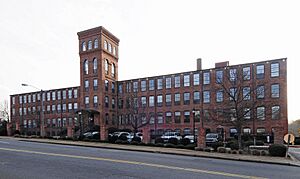
- Cancer Survivors Park: This park opened in 2018.
- The Children's Museum of the Upstate: This is one of the first children's museums to be connected with the Smithsonian.
- Falls Park on the Reedy: This large park in the West End has gardens and waterfalls. You can also get to the Swamp Rabbit Trail from here. The park opened in 2004. It cost $15 million. It has the Liberty Bridge, a pedestrian bridge over the Reedy River. The park helped bring new development to the area. The Liberty Bridge was built in 2004.
- Greenville County Museum of Art: This museum focuses on American art. It has works by Andrew Wyeth and Jasper Johns. It also has modern art by artists like Andy Warhol and Georgia O'Keeffe.
- Greenville Zoo: The zoo started in 1960. It is located in Cleveland Park.
- Linky Stone Park: The Children's Garden: This 1.7-acre garden lets you use all five senses to experience flowers. It has a geology wall with local rocks. It also has a textile garden, a Hansel and Gretel cottage, and a secret garden.
- McPherson Park: This is the city's oldest park. It has a free miniature golf course.
- Roper Mountain Science Center: This center has a historic 23-inch telescope. It is the eighth largest of its kind in the United States.
- Runway Park at GMU: This is a great spot to watch planes take off and land. It has an educational area, walking paths, and an aviation-themed playground.
- Shoeless Joe Jackson Museum & Baseball Library: This museum is in the historic home of baseball player Shoeless Joe Jackson. It is next to Fluor Field at the West End.
- Swamp Rabbit Trail: This 22-mile greenway connects downtown Greenville to the City of Travelers Rest. In 2023, a 4.5-mile extension opened. It connects Cleveland Park to the Clemson University International Center for Automotive Research.
- Unity Park: This 60-acre park opened in May 2022. It is along the Reedy River. It has basketball courts, a baseball field, a splash pad, and a welcome center. Five walking trails connect to the Swamp Rabbit Trail. The park brought together two former segregated parks.
- Upcountry History Museum: This is the area's largest history museum. It is connected with the Smithsonian.
Fun Festivals in Greenville
- Artisphere: A three-day art festival held every spring. It features musicians, visual artists, and street performers.
- Euphoria Greenville: An annual four-day food, wine, and music festival in September. It includes cooking lessons and dinners by famous chefs.
- Fall for Greenville: A three-day music and food festival held every fall. It has hundreds of food items and many musical artists on six stages.
- First Fridays Gallery Crawl: More than 30 art galleries open to the public for free. It happens on the first Friday of every month from 6 p.m. to 9 p.m.
- The Greek Festival: A three-day festival by the Greek Orthodox Church. It celebrates Greek culture with dance, music, and food.
- Greenville Jazz Fest: Celebrates jazz music and culture. The first event in 2023 included the Grammy-winning Rebirth Brass Band.
- Greenville Open Studios: An annual three-day event where 158 local artists open their studios to the public.
- iMAGINE Upstate: A weekend event that shows off STEM (Science, Technology, Engineering, Math), business, and creative activities. It promotes learning through hands-on activities.
- Indie Craft Parade: A festival of handmade art held every September. It features over 100 artists, local food, and a free photo booth.
- New South Comedy Festival: A ten-day comedy festival. It features improv, stand-up, sketch, and musical comedy from around the country.
- SC Comicon: A two-day comic book convention held every year. Thousands of people attend, many dressed in cosplay.
- Upstate Shakespeare Festival: Performs plays by Shakespeare and other classic plays each summer in Falls Park.
Visual Art in Greenville
Many local artists have studios and galleries in Greenville. Especially in the Village of West Greenville near downtown. The Metropolitan Arts Council hosts public events about visual arts. These include the First Fridays Gallery Crawl and Greenville Open Studios. Greenville has some notable fine art museums:
- Bob Jones University Museum & Gallery: This museum has a diverse collection of European masterworks.
- Greenville County Museum of Art: This museum is home to the Andrew Wyeth Collection. It also has pieces by Jackson Pollock, Georgia O'Keeffe, and Jasper Johns.
Music Scene in Greenville
Greenville's music scene has local, regional, and national bands. The city is home to the Greenville Symphony Orchestra. There are also youth orchestras and concert bands. Greenville Light Opera Works (GLOW Lyric Theatre) is a professional theater. It produces musical theater, operetta, and opera.
Local singing groups include the Vocal Matrix Chorus (women) and the Palmetto Statesmen chorus (men). Other singing groups are the Greenville Chorale and the Greenville Gay Men's Chorus.
Greenville also has the Sigal Music Museum. It used to be called the Carolina Music Museum. In the 1930s, the building was a Coca-Cola bottling company.
Dance and Theater in Greenville
The Carolina Ballet Theatre is a professional dance company. They perform regularly at the Peace Center. They put on four shows a year. Their biggest show is "The Nutcracker, Once Upon A Time in Greenville." This show is like those put on by major dance companies in their hometowns.
Centre Stage, Greenville Theatre, South Carolina Children's Theater, and the Warehouse Theatre are the main playhouses. They offer many different performances. These include famous plays like Death of a Salesman and Grease. They also show plays written by local writers. In spring and summer, the local Shakespearean company performs Shakespeare in the Park. This happens at the Falls Park Amphitheater.
Literary Arts in Greenville
Two non-profit groups for writers are in Greenville. The Emrys Foundation started in 1983. Wits End Poetry started in 2002.
Sports in Greenville
The National Christian College Athletic Association (NCCAA) sports office is in Greenville. The city also has various minor league and university sports teams.
Minor League sports teams:
- Greenville Drive: This is a baseball team. They are connected to the Boston Red Sox. They play at Fluor Field at the West End. The stadium looks like Fenway Park, the Red Sox's home field. Before 2006, they were called the Greenville Bombers.
- Greenville Liberty SC: This is a women's soccer team. They started playing in 2022. In their first season, they were champions of their division. They play at Paladin Stadium at Furman University.
- Greenville Swamp Rabbits: This is a minor league hockey team. They started playing in 2010. They were renamed in 2015.
- Greenville Gaels: This is a hurling team. Hurling is an Irish sport.
- Greenville Triumph SC: This is a soccer team. They play in USL League One. They have been in the league finals three times. They won the championship once in 2020. They play at Paladin Stadium at Furman University.
- Bob Jones University's sports teams are called the BJU Bruins. They compete at the NCCAA Division II level. They started playing college sports in 2012. They began with soccer and basketball. In 2020, the Bruins were accepted into the NCAA Division III level. As of 2023, the university has 12 sports teams.
Furman University
- The Furman Paladins compete at the NCAA Division I level. Their football team is in the NCAA Football Championship Subdivision. Furman teams play on campus. Their venues include Paladin Stadium and Timmons Arena. Furman is part of the Southern Conference.
North Greenville University
- North Greenville University's mascot is the Crusader. They compete at the NCAA Division II level.
Education in Greenville
Schools for Kids and Teens
The Greenville County School District covers all of Greenville city. It is the largest school district in South Carolina. It is the 44th largest district in the United States. It has 19 high schools, 24 middle schools, and 52 elementary schools. In 2018, the district had 10,000 employees. This included 6,000 teachers.
Greenville also has the South Carolina Governor's School for the Arts & Humanities. This is a boarding school for young artists.
There are many private and religious schools in Greenville County. These include St Mary's Catholic School, Camperdown Academy (for learning disabilities), and Christ Church Episcopal School. Other schools are Shannon Forest Christian School, Saint Joseph's Catholic School, and Southside Christian School. There are also Hampton Park Christian School, Bob Jones Academy, and Greenville Classical Academy. Green Charter is a public charter school. Public charter schools are free for South Carolina residents.
Colleges and Universities in Greenville
Greenville has several colleges and universities. These include Bob Jones University, Greenville Technical College, and an ECPI University campus. Furman University and North Greenville University are also in the greater Greenville area.
Furman University started in 1825. It was named after Richard Furman. Its theology school later became Southern Baptist Theological Seminary. North Greenville University started in 1893. It is connected with the South Carolina Baptist Convention. Bob Jones University started in 1927. It is a private Christian university. Greenville Technical College started in 1962. The Evangelical Institute was founded in 1967.
Clemson University's main campus is 30 miles away. But it has programs in Downtown Greenville. It also has a special campus in Greenville. It is called the Clemson University International Center for Automotive Research. It focuses on car research.
The University of South Carolina School of Medicine Greenville is a four-year medical school. It operates on a Prisma Health campus.
The University Center of Greenville offers over 70 programs. These are from 9 South Carolina universities. The schools include Anderson University, Clemson University, Furman University, and the University of South Carolina.
Media in Greenville
Greenville has many local news sources:
- Greenville Business Magazine: A monthly magazine with business information.
- The Greenville News: The city's daily newspaper. It is the largest daily newspaper in the Upstate.
- Greenville Journal: A weekly newspaper about business, local events, and issues.
- GSA Business: Published every two weeks. It covers business news from the Greenville area.
- GVLtoday: A local news website.
- The Post and Courier Greenville: A local edition of a Charleston newspaper. It has news written by Greenville journalists.
- Upstate Business Journal: A weekly business newspaper.
- ShareGVL (Share Greenville): A non-profit digital community. It shares stories about Greenville residents.
Radio Stations
Greenville is part of a large radio market. The box below lists the local radio stations:
Television Stations
Greenville is part of a large television market. The box below lists the local television stations:
Transportation in Greenville
Greenville is on the Interstate 85 (I-85) highway. It is about halfway between Atlanta and Charlotte. I-85 runs along the city's southeast side. Two other highways connect to downtown Greenville: I-185 and I-385. Other major highways include U.S. Route 123, U.S. Route 25, U.S. Route 29, and U.S. Route 276.
There are several airports near Greenville. The largest is Greenville-Spartanburg International Airport (GSP). It is the second busiest airport in South Carolina. Most major airlines use it. SCTAC (formerly Donaldson Air Base) has been updated. It is home to many industries. It also has the International Transportation and Innovation Center (ITIC). Greenville is a freight hub for FedEx Express. The Greenville Downtown Airport is the busiest general aviation airport in South Carolina.
Greenville's public transportation is called Greenlink. It runs a bus system that serves Greenville and much of Greenville County. Greenlink has a plan to cover the entire county by 2030. They plan to add 15 new buses and run routes more often.
Greenville has an Amtrak station. It is part of Amtrak's Crescent train route. This train connects Greenville to cities like New York, Washington, D.C., Charlotte, and Atlanta. Greenville is also part of a plan for a high-speed rail line. Freight train service is provided by CSX Transportation and Norfolk Southern Railway. An old train line to Travelers Rest has been turned into a hiking and biking trail. It is called the Swamp Rabbit Trail.
Famous People from Greenville
- Jaimie Alexander, actress
- Dorothy Allison, writer
- Cat Anderson, jazz trumpeter (1916–1981)
- Rudolf Anderson Jr., the only person killed by enemy fire during the Cuban Missile Crisis
- Daniel Bard, MLB player
- Zinn Beck, former MLB player and manager
- Danielle Brooks, actress, grew up in Simpsonville and attended SCGSAH in Greenville
- Peabo Bryson, singer-songwriter
- Carroll A. Campbell, Jr., former governor of South Carolina
- Judith Chapman, actress
- Dextor Clinkscale, NFL safety
- William Wilson Cooke (1871–1949), architect
- Wilson Cooke (1819 –1887), politician and merchant
- Santia Deck, athlete
- Jim DeMint, U.S. senator
- Austin Ernst, professional golfer
- Esquerita, musician
- Jawun Evans, NBA player
- Tyler Florence, chef and TV host
- Kevin Garnett, NBA player
- André Goodman, NFL cornerback
- Trey Gowdy, United States congressman
- Chad Green, MLB pitcher
- Clement Haynsworth, United States Circuit Judge
- James M. Henderson, advertising executive
- George Hincapie, road bicycle racer
- John D. Hollingsworth, textile executive
- Bo Hopkins, TV and film actor
- Jesse Hughes, rock musician
- Jay Jackson, MLB pitcher
- Jesse Jackson, civil rights activist
- Shoeless Joe Jackson, MLB player
- Bob Jones Sr., evangelist and founder of Bob Jones University
- Bob Jones Jr., second president of Bob Jones University
- Monique Jones, professional bodybuilder
- Jo Jorgensen, Libertarian presidential candidate
- Marcus King, blues musician
- Nikki Lane, country music singer
- Hovie Lister, gospel musician
- Michael Mercado, MLB pitcher
- Joel Roberts Poinsett, physician, diplomat, and slave owner
- Virginia Postrel, author
- Charles H. Townes, Nobel Prize winner in Physics
- Eli White, professional baseball player
- Josh White (1914–1969) American singer and civil rights activist
Sister Cities
Greenville has special connections with these cities around the world:
 Bergamo, Italy (since 1984)
Bergamo, Italy (since 1984) Kortrijk, Belgium (since 1991)
Kortrijk, Belgium (since 1991) Tianjin Free-Trade Zone, China (since 2002)
Tianjin Free-Trade Zone, China (since 2002) Vadodara, India
Vadodara, India
See also
 In Spanish: Greenville (Carolina del Sur) para niños
In Spanish: Greenville (Carolina del Sur) para niños



